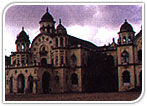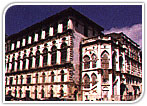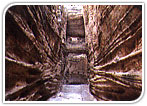 Junagadh
was the capital of the Junagadh State under the Muslim rulers of Babi
Nawabs. In Gujarati, `Junagadh' literally means an ancient fort. The
junagadh town is located at the foothills the sacred hill of Girnar and
occupies a special place in the history of Gujarat.
Junagadh
was the capital of the Junagadh State under the Muslim rulers of Babi
Nawabs. In Gujarati, `Junagadh' literally means an ancient fort. The
junagadh town is located at the foothills the sacred hill of Girnar and
occupies a special place in the history of Gujarat. The history of junagadh is chequered by the rules of the Mauryans, Kshatrapas, Guptas, Vilabhis, Chudasamas, Gujarat Sultans and Babi Nawabs. Junagadh, at different times in history, was under the influence of four major religions. Hindu, Bhuddhist, Jain and Muslim. Both political powers and religious influences enriched the culture and created edifices leaving their mark on the architecture of Junagadh.
There are two fortifications: the fort walls surrounding the town and Uparkot in the west. Uparkot, an ancient citadel located on the higher level of the town, was a stronghold of Mauryans and Gupta Empire and is said tp have survived 16 sieges in the last 1000 years due to its strategic location and difficult access. The entrance of Uparkot has a fine specimen of Hindu Toran, leading to flat land dotted with archological sites. The major sites are Buddhist caves, Baba Pyara caves (2nd century), Adi-Kadi Vav, Navghan Kuvo and Jami Masjid.
 The
Buddhist caves are fine examples of rock cut architecture with ornamented
pillars, carved entrances, water cisterns, chaitya hall, monastic cells
for meditation and chaitya windows. The Khapara-Kodia caves located in the
town are also worth visiting.
The
Buddhist caves are fine examples of rock cut architecture with ornamented
pillars, carved entrances, water cisterns, chaitya hall, monastic cells
for meditation and chaitya windows. The Khapara-Kodia caves located in the
town are also worth visiting.Adi-kadi Vav and Navghan Kuvo were built by the Chudasama Rajputs and are unique water structures among the numerous step wells of Gujarat. Both these served as sourcesf during teh sieges lasting for years and were essential parts oft he basic need of the hill fort. The Adi-Kadi Vav(15th century) has a long flight of 120 steps leading to water, while the Navghan Kuvo (1260AD) is hewn from soft rock and is 52 meter deep, reached by a circular staircase winding around the shaft.
Jami Mosque was originally a palace of Ranakdevi, converted into a mosque by Muhammad begada to commemorate his victory over Junagadh in 1470 AD. Another interesting artefact from past is `Nilam' canon, brought to Diu from Egypt to fight against the Prortuguese and it was manufactured by the order of Suleyman, the Magnificent, King of Turkey.
 The
Babi rulers of Junagadh, Nawab Mahobat Khat II (1851-82 AD)undertook the
beatification of Junagadh and patronized the construction of several
building and urban design projects like Aina Mahal, Circle Chowk with
clock tower and Dewan Chowk. Other important buildings of the Nawabi
period are Bahauddin College, Manoranjan Guest House, Mahobat Madresa
(Narsi Vidya Mandir). The most interesting structures are the maqbaras
(musoleums) of the Royal Family. The group of maqbaras represent the
creative and eclectic phase of Nawabi architecture of Junagadh (1878-1911
AD). All the architectural elements are phase of Nawabi architecture of
Junagadh (1878-1911 AD). All the architectural elements are highly
decorative and remind one, of the last phase of architecture of Lucknow.
The
Babi rulers of Junagadh, Nawab Mahobat Khat II (1851-82 AD)undertook the
beatification of Junagadh and patronized the construction of several
building and urban design projects like Aina Mahal, Circle Chowk with
clock tower and Dewan Chowk. Other important buildings of the Nawabi
period are Bahauddin College, Manoranjan Guest House, Mahobat Madresa
(Narsi Vidya Mandir). The most interesting structures are the maqbaras
(musoleums) of the Royal Family. The group of maqbaras represent the
creative and eclectic phase of Nawabi architecture of Junagadh (1878-1911
AD). All the architectural elements are phase of Nawabi architecture of
Junagadh (1878-1911 AD). All the architectural elements are highly
decorative and remind one, of the last phase of architecture of Lucknow.The 14 rock edicts (257-56 BC) of the great Emperor Ashoka, inscribed on a huge stone in Pali script, inscrption by King Rudradaman (150 AD) and Skandagupta (456 AD) are the proof of importance of Junagadh from ancient times. The city was home to one of the great poets of India, Narsinh Mehta (15th century). He was an ardent devotee of Lord Krishna, a scholar, philosopher and a social reformer. The `Narsinha Mehta no Choro' near Najewadi Gate was a platform for his religious discouses and Bhajans. Other places to be visited are the Sakkarbag Zoo, Welingodn Dam, Damodar Kund, Bhavnath Temple, city Rajmahal and Darbar Hall Museum. Girnar is a sacred hill with five peaks visited by millions of Hindus and Jains. The Mahashivratri fair held here is attended by naga sadhus and pilgrims from all over India.
Excursion:
Gir National Park (the only home of Asiatic Lions)60 km, Prabhas patan-Somnath (one of eh twelve most sacred Shiva Shrines)79km, Chorwad (a delightful resort on the beach) 72 km.
Travel Information
Air:Nearest Airport is Keshod (40km), Porbandar(113 km)
Train: Railway Station of Ahmedabad-Junagadh and Rajkot-Junagadh line
Road: Rajkot(102km),Porbandar(113 km), Ahmedabad (327 km)
Local transport:Non-Metered Autorickshaws and Local buses
Accomodation:Several hotels of diffferent category
Food:Local eating Joints
Special Offers on Hotels & Resort Booking in Junagarh
Travel Agents & Tour Operators offering Travel Packages to Junagarh